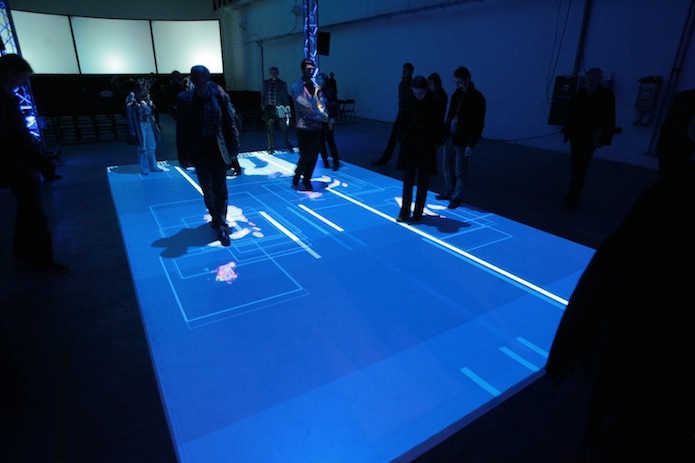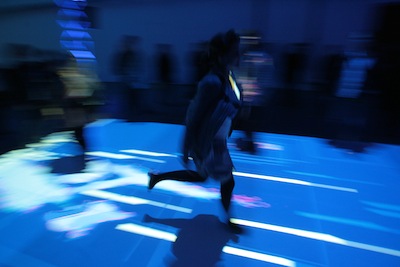|
Mapping Chopin Mapping Chopin, video by Ania Ejsmont Paweł Janicki’s installation Mapping Chopin creates an immersive interactive environment that allows viewers/listeners to experience the music in an intuitive and unstructured way. Specially designed software combined with a motion-detection system generates variations on digitalized scores of Chopin’s pieces based on the behavior of the audience/participants. Janicki’s installation uses Chopin’s Etude in A-flat major Op. 25 No.1, Valse Brillante in A Minor Op. 34 No. 2, Tarantella in A-flat major Op. 43 and Nocturne in G minor Op. 15 No. 3. Various musical parameters of the works – the dynamic range, tempo, articulation, etc. – are associated with data provided by the motion-detection system, so that people within the installation space can, through their own activity, generate phrases and longer passages. The data from the motion-detection system are also mapped onto the vertical and horizontal axes of the musical score, creating a graphic allusion to the physical installation space as well as to the keyboard projected in it, and highlighting the sequencing of the notes in the compositions and the way they’re linked to the space and to the movements of the audience/participants. The score is treated as a space where we can move in real time, and where we can discover various sound events and the relationships among them. The data flow modulates the typical piano voicings, enhancing the “natural” quality of the sound and heightening the participants’ sense of direct control over the music being generated. Because the installation’s sensitivity and main parameters are continually adjusted to the number and nature of input stimuli, it can be experienced by solo participants or groups.
Mapping Chopin was commissioned by the WRO Art Center and it was funded by the Polish Ministry of Culture and National Heritage and the Polish Institute in London. The installation is a part of Where's Chopin project organised jointly by the Polish Cultural Institute, the WRO Art Center in Wrocław and Stanford University, as part of 2010 Chopin Year Celebrations. Three landmark installations presenting completely new interpretations of Chopin’s music, integrating some of his most popular piano works with high technology to create powerful visual accompaniments, revealing the timeless power and appeal of Chopin’s music well beyond conventional concert-hall recitals. The exhibition is a collection of interactive installations that transplant Chopin’s work to the terrain of contemporary art and digital media. Three new audiovisual installations have been created by three Polish artists – Józef Robakowski, Jarosław Kapuściński and Paweł Janicki – using unconventional strategies to engage with music. Frédéric Chopin’s works are treated as a basis for reinterpretation, defragmentation and reconstruction, and their new nonlinear structure is enhanced by the relationship between sound and image. 
|
 The installation is a part of Where's Chopin project organised jointly by the Polish Cultural Institute, the WRO Art Center in Wrocław and Stanford University, as part of 2010 Chopin Year Celebrations.
The installation is a part of Where's Chopin project organised jointly by the Polish Cultural Institute, the WRO Art Center in Wrocław and Stanford University, as part of 2010 Chopin Year Celebrations. Read more about Where is Chopin exhibition on the WRO Art Center website.
Read more about Where is Chopin exhibition on the WRO Art Center website. Polish Institute in London
Polish Institute in London Polish Ministry of Culture and National Heritage
Polish Ministry of Culture and National Heritage Warsaw Autumn Contemporary Music Festival
Warsaw Autumn Contemporary Music Festival Dilston Grove, London
Dilston Grove, London Premiering simultaneously:
Premiering simultaneously: